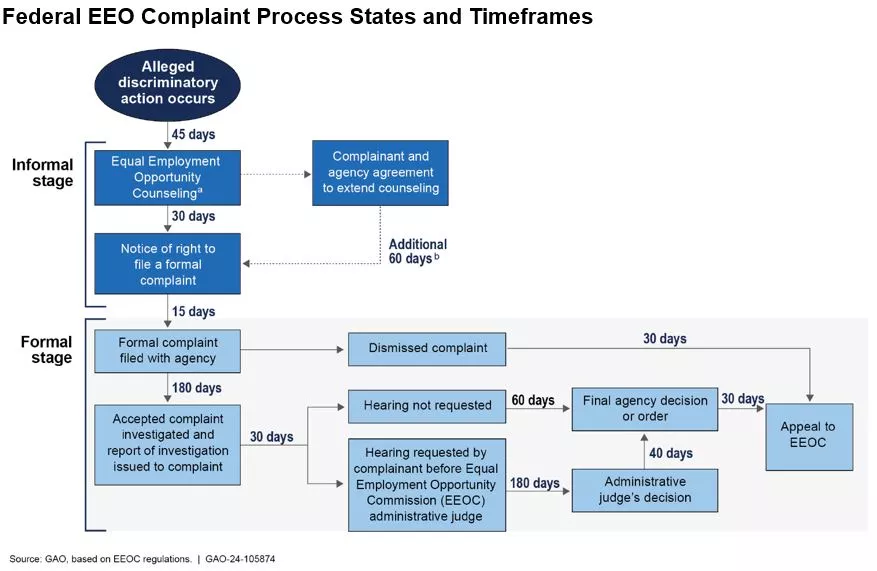Combatting Discrimination in Our Nation’s Largest Employer—the Federal Government
Note: This post was updated on June 26 to change the description of EEO laws.
The federal government is our nation’s largest employer with more than 2 million workers. Equal opportunity laws and regulations are meant to ensure workplaces are free from discrimination. But investigations by analysts here at GAO and Office of Inspectors General, as well as reported increases in discrimination at federal agencies, suggest more work is needed. For example, in 2021, 12% of federal workers reported experiencing sexual harassment in the prior 2 years.
Today’s WatchBlog post looks at our new report on the requirements intended to protect federal workers and the improvements needed in oversight of equal employment opportunity (EEO) laws.
Image

What do federal EEO laws require of agencies?
In short, EEO laws are federal laws that prohibit employment discrimination based on race, color, religion, sex, national origin, age, or disability. Federal agencies are required to:
- Complete an annual self-assessment of their EEO program—Agencies must assess their EEO programs to identify weaknesses and develop plans to address them.
- Collect and report complaint data—Agencies must also report the number of employees disciplined for discrimination, retaliation, or any other infraction. For transparency, agencies must also publicly post summary data on EEO complaints filed by current or former employees.
- Meet required timeframes for complaint processing—Agencies are required to meet deadlines (see figure below). For example, agencies have 180 days to investigate complaints and 60 more days to issue a final decision. But we found agencies often missed these deadlines.
Image

Agencies face some common challenges that hinder EEO efforts
Many agencies face weaknesses—in some cases persistent ones. For example:
- Missing deadlines. Eight of the 24 agencies in our review did not complete investigations of complaints within the 180 days required. Similarly, 16 of 24 agencies did not meet the required deadline for issuing a final decision on a EEO complaint. In particular, we found that the Department of Transportation consistently exceeded timeframes allowed for making these decisions. Although, officials told us they have put plans in place to address this issue.
- Missing anti-harassment policies. Our review found that 16 of 24 agencies didn’t have required comprehensive anti-harassment policies. These policies are important because they are meant to clearly explain prohibited conduct and assure employee protections against retaliation.
- Organizational structure of EEO program did not comply with the law. We also found that EEO program directors at 11 out of 24 agencies did not report to the head of the agency as required. This allows agency heads to provide direct responsibility over the person with day-to-day responsibilities for EEO and allows for unfettered discussions about the agency’s policies and practices. One of the agencies we studied, the U.S. Agency for International Development, restructured its program to address this issue during our review.
- Underusing alternate dispute resolution options. Finally, 12 out of 24 agencies underused alternate methods to litigation to resolve EEO disputes, such as mediation, negotiation, or arbitration. Many agencies continued to rely on traditional, generally more, adversarial methods. Alternate dispute resolution methods could provide employees with quick relief from harassment or discrimination.
Gaps in oversight undermine employees’ EEO protections
Issues like those described above can undermine EEO efforts. The Equal Employment Opportunity Commission (EEOC) is responsible for helping federal agencies comply with the law, support their efforts, and provide resources for addressing deficiencies. But in our new report, we found that EEOC’s oversight could be improved. For example, EEOC’s current processes makes it hard to know whether agencies are submitting required reports containing self-identified program weaknesses. Improving EEOC’s monitoring process would result in better information about persistent EEO weaknesses.
We also found that EEOC does not use its processes for notifying Congress about instances of persistent agency noncompliance. Such notifications could be a powerful tool for holding agencies accountable for ensuring that its workplaces are free from discrimination.
We made four recommendations in our new report to help improve EEOC’s oversight processes. Learn more by reading our full report.
- GAO’s fact-based, nonpartisan information helps Congress and federal agencies improve government. The WatchBlog lets us contextualize GAO’s work a little more for the public. Check out more of our posts at GAO.gov/blog
GAO Contacts
Related Products

GAO's mission is to provide Congress with fact-based, nonpartisan information that can help improve federal government performance and ensure accountability for the benefit of the American people. GAO launched its WatchBlog in January, 2014, as part of its continuing effort to reach its audiences—Congress and the American people—where they are currently looking for information.
The blog format allows GAO to provide a little more context about its work than it can offer on its other social media platforms. Posts will tie GAO work to current events and the news; show how GAO’s work is affecting agencies or legislation; highlight reports, testimonies, and issue areas where GAO does work; and provide information about GAO itself, among other things.
Please send any feedback on GAO's WatchBlog to blog@gao.gov.




